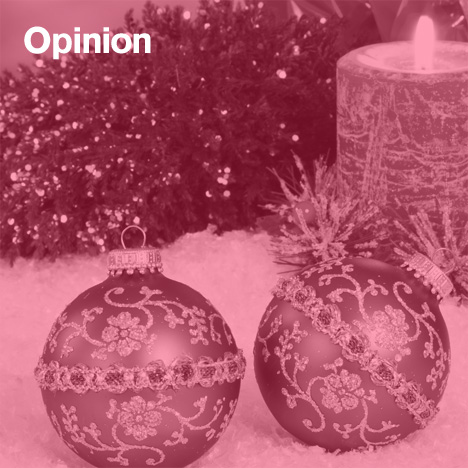Opinion: Sam Jacob argues that as climate change pushes the reality of winter further from the idealised version that appears in Christmas decorations, they begin to represent "a hangover of a vanishing idea remade through other technologies."
Picture the scene. Well, actually, it’s harder not to now that Christmas adverts have been “premiered” and are on the kind of constant rotation that bores into your mind’s eye like an augewurm. These scenes have been pre-pictured for you with the kind of luminous intensity that only million pound budgets and the most expensive of heartwarming celebrities provide. There are tables as big as airfields piled high with hams, cakes and turkeys, there are Disneyfied animals acting anthropomorphic sentiments, jumpers seen through Super 8 vision and snow falling over everything.
Out in the streets, council cherry pickers are draping trees in strings of lights, attaching stars to lamp posts and strapping pine trees to buildings. Shop windows have become landscapes of abstract wintriness: a silver birch forest has grown up in the window of Top Shop, there are drifts of cotton wool in Accessorize and glistering electric ice in La Senza.
Pubs spray a polystyrene porridge of fake snow into the corners of their windows: instant graffitied Dickensification. Strange fruits of platonic metallic spheres have sprouted on trees uprooted from their plantations.
There’s a flurry of white balls frozen above the grey morass of Oxford Street and giant frozen boughs arc across Regent Street, sparkling with electricity. Almost everywhere there are super-scaled outlines of snow crystals, laser cut from Day-Glo perspex or vinyled onto plate glass, shrinking us to microscopic size.
This trail of decoration is an alternate landscape, a continuous environment bleeding from our own decked-out-homes, through a city transformed with temporal forests and artificial constellations blinking above. It’s a 1:1 replica of a winter that never existed in all its synthetic, scenographic glory.
Piles of beautifully wrapped empty cardboard boxes are piled under corporate trees - a gesture of empty generosity as to fulfil our need to know that our contemporary Christmassy symbolism is entirely hollowed out.
All these decorative tools and devices have their roots in misty Pagan prehistory. The symbols and customs we use even now come from an ancient and superstitious relationship with nature. They were ritualistic acts ushering the sun back into ascent from the depths of the winter solstice, there to welcome the return of light and warmth. Evergreens, berries and fire were fertility rites concerned with renewal and rebirth. In even the most tawdry strings of tinsel are echoes of these long forgotten ancient magics. These symbols have been processed through thousands of years of culture so that their real roots are obscured, bent into countless other shapes by other belief systems, ideologies and practices.
Christmas decorations are the ultimate floating signifiers dangling off the boughs of harvested evergreens. Cut loose from their original meanings and myths, they are a semiological ding dong where bells, angels wings, holly and snow are packed together into a fabric as dense as Christmas cake, covering everything like wrapping paper. Denuded of their original meaning, decorations become a simple statement of fact: signs that denote winter, erected slap bang in the middle of real winter.
Our modern selves might feel entirely sophisticated, shed of superstition and primitive ritual. We might feel far removed from the pagan roots of this decorative urge, but perhaps there is something within us that drives our fervour for winter decorations, something driving us to these extraordinary ends - especially a society otherwise so cynical and resistant to forced entertainment and group sentiment.
It was science that assuaged our ancient pagan fear of a sunless never-ending Narnia, but it’s science, too, that raises contemporary fears for the future of our environment. As study after study shows, winter itself is threatened.
Climate change studies see the growing season extending as though it were an ink blot bleeding across the calendar. Winter season in the arctic is almost two weeks shorter than it was a few decades ago. Measuring the growth of plants reveals British spring occurring ten days earlier than the 1970s. This season creep is estimated to have been advancing spring by two to three days and delaying autumn by 0.3–1.6 days per decade over the past 30 to 80 years.
These are our modern fears for the environment, as deeply troubling as any ancient superstition, perhaps even more so given their foundation in fact. They have consequences for just the same things that the Pagans feared: a total disruption of the Earth’s ecosystem causing loss of the northern permafrost, rises in sea levels, decoupling of breeding and feeding patterns, disruption of migration and so much more that we have yet to fully appreciate.
Climate change means the apparent natural pattern of winter, the one depicted with such certainty by all of our Christmassy imagery is (if it ever was) an imaginary scene. Perhaps it’s more: a ritual that unconsciously reverses our old Pagan desire and makes a superstitious plea for winter to stay. Perhaps it’s even worse than this: maybe it’s winter as skeuomorphism, a hangover of a vanishing idea remade through other technologies. Perhaps a trip down Oxford Street’s commercially manufactured, abstracted visions of winter is nothing less than a salve to our latent environmental nightmares.
Sam Jacob is a director of architecture practice FAT, professor of architecture at University of Illinois Chicago and director of Night School at the Architectural Association School of Architecture, as well as editing www.strangeharvest.com.

